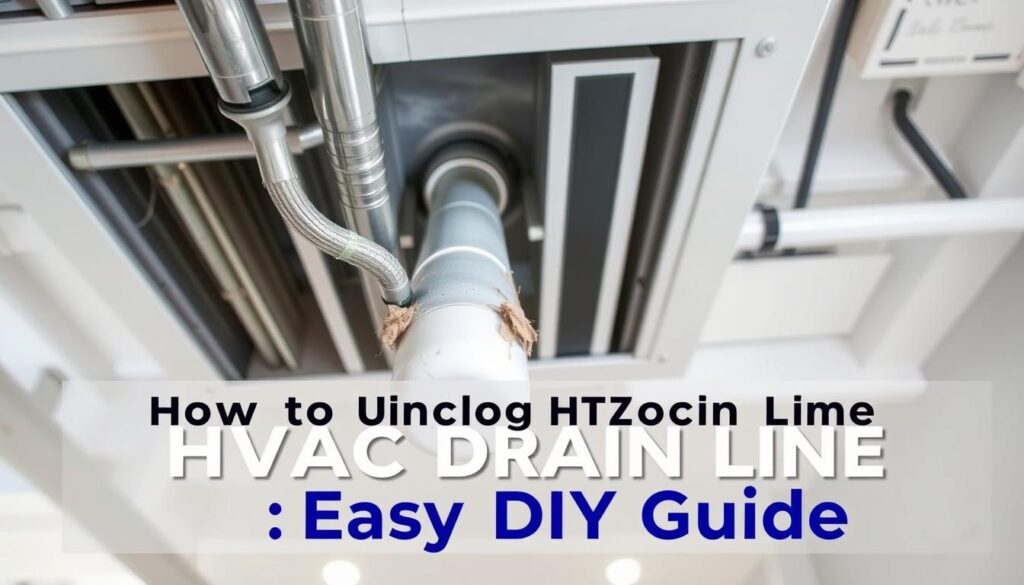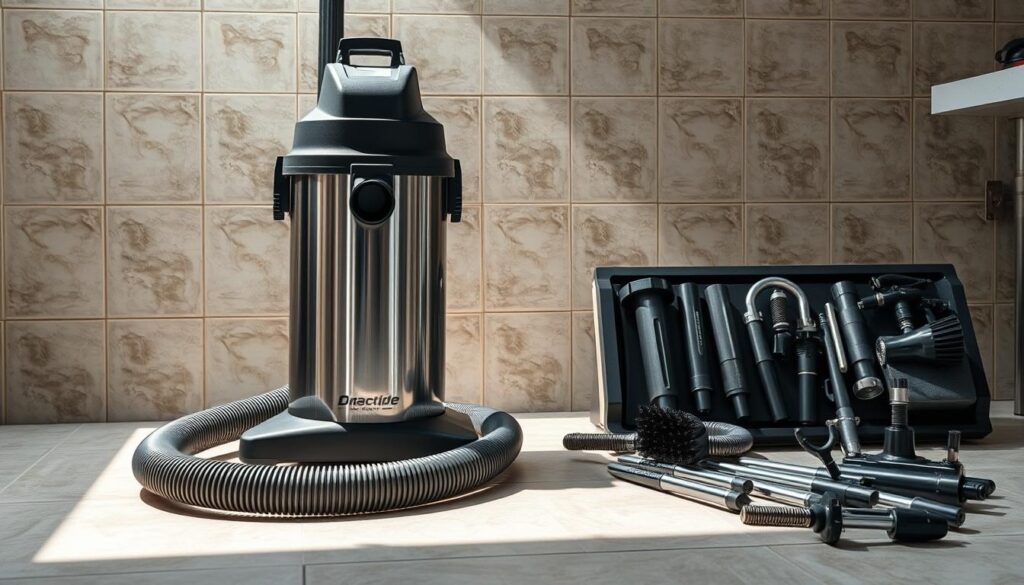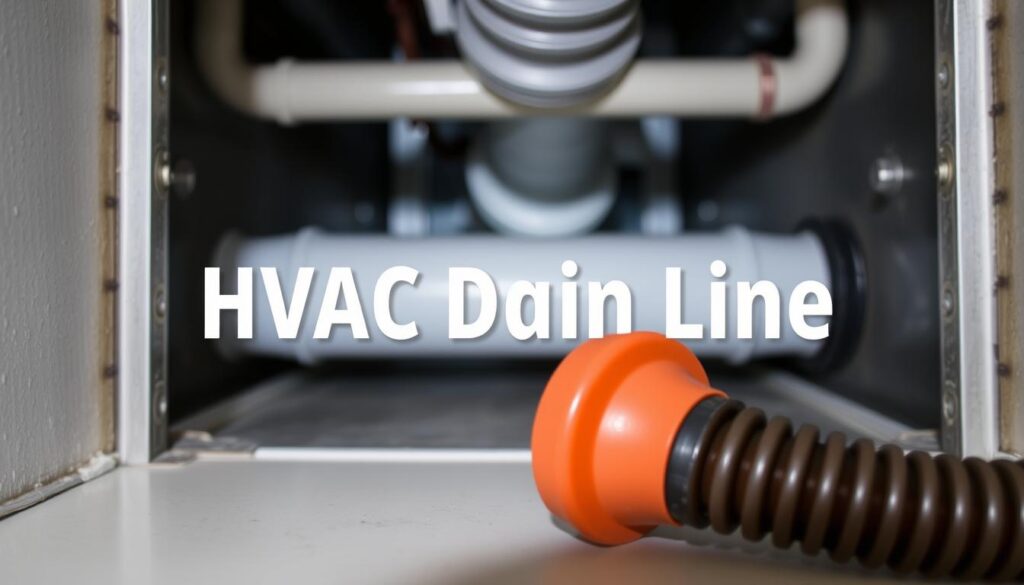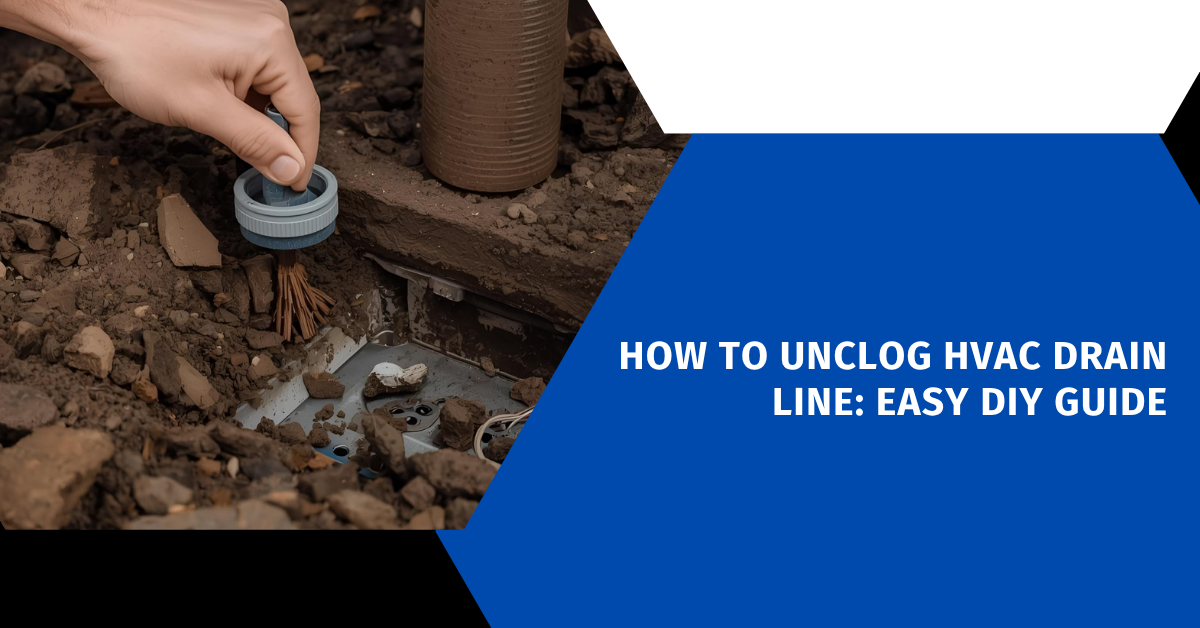Affiliate Disclosure
HVAC Guide Guys is a participant in the Amazon Services LLC Associates Program, an affiliate advertising program designed to provide a means for sites to earn advertising fees by advertising and linking to Amazon.
How to Unclog HVAC Drain Line? Are you tired of dealing with mysterious water leaks and inefficient air conditioning? What if a simple DIY solution could save you hundreds of dollars in professional repair costs?

Air conditioners are key for comfort during hot summer months. But, a clogged HVAC drain line can quickly ruin your cooling space. Learning to unclog an HVAC drain line is crucial to prevent water damage and keep your system working well.
This guide will show you how to clean your air conditioner’s condensate drain. It will help you deal with drain line issues confidently and effectively.
Key Takeaways
- Learn the basics of HVAC drain line maintenance
- Understand common causes of drain line clogs
- Discover simple DIY cleaning techniques
- Save money by avoiding professional service calls
- Prevent potential water damage to your home
Table of Contents
Understanding HVAC Drain Line Basics
Your home’s HVAC system has a key part called the condensate drain line. It helps manage moisture. This part is crucial for keeping your home comfortable and safe from water damage.
Keeping your air conditioning system in good shape is important. The carrier ac drain line is key for removing extra moisture. This is what happens when your AC cools the air.
What is a Condensate Drain Line?
A condensate drain line is a special pipe. It takes away water made by your air conditioning system. When your AC cools the air, it makes moisture. This moisture needs to be safely moved away from your equipment and home.
- Collects water from the air conditioning unit
- Prevents water buildup around your HVAC system
- Protects your home from potential water damage
How Drain Lines Function
The drain line works in a simple way. Warm air meets the cold evaporator coil, making water droplets. These droplets gather in a drain pan and then go out through the condensate drain line.
| Component | Function |
|---|---|
| Evaporator Coil | Creates condensation by cooling warm air |
| Drain Pan | Collects water droplets |
| Condensate Drain Line | Removes collected moisture from the system |
Common Causes of Clogs
Your condensate drain line can get blocked by different things. Knowing these common problems helps you avoid them:
- Algae and mold growth
- Dust and debris accumulation
- Mineral deposits from hard water
- Improper system installation
Regular maintenance and cleaning can stop these problems. This keeps your HVAC system working well.
Safety Precautions Before Starting
Before starting your diy drain line cleaning, safety is key. Working with HVAC systems needs careful preparation and protective steps. This is to avoid injuries or damage to the system.
First, make sure to turn off the HVAC system completely. Electrical safety is crucial during maintenance. Find your circuit breaker and switch off the power to your air conditioner. This step prevents electrical shock.
- Turn off power at the circuit breaker
- Verify system is completely powered down
- Use a voltage tester for confirmation
Wearing personal protective equipment is vital for safe cleaning. Use gear that protects you from harmful substances and prevents injuries.
| Safety Equipment | Purpose |
|---|---|
| Safety glasses | Prevent eye contamination |
| Rubber gloves | Avoid direct contact with debris |
| Dust mask | Prevent inhalation of mold spores |
Remember, there are risks in drain line maintenance. Improper handling can cause water damage, mold, or system failure. If unsure, it’s best to get help from a professional HVAC technician.
“Safety isn’t expensive, it’s priceless.” – Unknown
Explore Our HVAC Shop
Looking for top-rated HVAC tools, parts, and accessories? Visit our shop and find the perfect solution for your needs.
Visit the ShopEssential Tools and Materials Needed
Getting ready for HVAC drain line maintenance means gathering the right tools and materials. You need the right equipment to clean and unclog your system well. This guide will show you what you need for a complete drain line cleaning.
Required Tools for HVAC Drain Maintenance
For your HVAC drain line, make sure you have these key tools:
- Wet/dry vacuum for HVAC drains
- Drain line snake or flexible cable
- Wire brush
- Screwdriver
- Bucket
- Protective gloves
Cleaning Solutions for Drain Line Care
Choosing the right cleaning solution is key for drain maintenance. Vinegar ac drain cleaning is a natural and effective way to break down buildup and prevent blockages.
- White vinegar – Natural cleaning agent
- Bleach solution
- Commercial HVAC drain line cleaner
- Hot water
Safety Equipment Recommendations
Keeping yourself safe during cleaning is very important. Always wear:
- Protective safety glasses
- Rubber gloves
- Dust mask
- Long-sleeved shirt
Pro tip: A wet/dry vacuum for HVAC drains can be a game-changer in removing stubborn clogs and moisture from your system. Pair it with vinegar ac drain cleaning for the best results.
Locating Your HVAC Drain Line Components
Finding the right parts for air conditioner condensate drain cleaning is key. It keeps your HVAC system running well. The drain line is important for removing moisture from your air conditioner.
Most homes have their HVAC drain lines in easy-to-find spots. You’ll usually see:
- Primary drain line near the indoor air handler
- Secondary drain line outside your home
- PVC pipe coming out of your home’s exterior wall
To find your HVAC drain line, start by looking near your indoor air handler or furnace. Look for a white or gray PVC pipe coming from the unit. This pipe usually goes to an exterior wall or right outside your home.
The outdoor end is near your exterior air conditioning unit. It looks like a vertical or slightly angled PVC pipe with a small opening. This is where the condensate water goes out during cleaning.
Pro Tip: If you’re unsure about the exact location, consult your HVAC system’s manual or take a quick photo to compare with manufacturer specifications.
Knowing where your drain line is helps you do maintenance better. It also stops water damage from clogged systems.
Explore Our HVAC Shop
Looking for top-rated HVAC tools, parts, and accessories? Visit our shop and find the perfect solution for your needs.
Visit the ShopHow to Unclog HVAC Drain Line
Clearing an HVAC drain line is key to avoid water damage and system inefficiency. Knowing how to unclog it helps your cooling system work better and saves you from expensive fixes.
Before starting, get your tools ready and set up your workspace. Good preparation is crucial for a successful unclog.
Step-by-Step Unclogging Process
- Turn off your HVAC system’s power at the circuit breaker
- Find the drain line access point near your indoor air handler
- Remove the drain line cap carefully
- Check the opening for any blockages
- Get your cleaning solution ready
Effective Cleaning Methods
There are several ways to clear an HVAC drain line:
- Wet/Dry Vacuum Method: Uses suction to pull out tough clogs
- Chemical Cleaning Solutions: Use special HVAC cleaners
- Vinegar Flush: A natural way to clean
Troubleshooting Clog Challenges
| Clog Symptom | Potential Solution |
|---|---|
| Water backing up | Check for complete blockage, use vacuum |
| Slow drainage | Apply vinegar solution, clean access point |
| Recurring clogs | Look for underlying system problems |
Unclogging your HVAC drain line needs patience and careful steps. If you face ongoing issues or feel unsure, it’s best to call a professional HVAC technician.
Using a Wet/Dry Vacuum Method

Clearing your HVAC drain line is easy with a wet/dry vacuum. This tool removes tough debris and stops water damage to your system.
To clean your HVAC drain effectively, you need to prepare well. Here are the steps to follow:
- Locate the primary drain line access point
- Ensure the HVAC system is completely turned off
- Create a tight seal between the vacuum and drain line
- Select appropriate vacuum settings
The wet/dry vacuum method is great for removing blockages. Experts say to use a vacuum with strong suction to get rid of debris well.
| Vacuum Type | Suction Power | Effectiveness |
|---|---|---|
| Standard Wet/Dry Vacuum | Medium | Good |
| Industrial Wet/Dry Vacuum | High | Excellent |
Before you start, wear gloves and eye protection. Put the vacuum hose into the drain line opening, making sure it’s sealed well. Run the vacuum for about 1-2 minutes to clear out water and debris.
Regular use of a wet/dry vacuum can save you from expensive HVAC repairs. It keeps your system running smoothly.
Explore Our HVAC Shop
Looking for top-rated HVAC tools, parts, and accessories? Visit our shop and find the perfect solution for your needs.
Visit the ShopNatural Cleaning Solutions and Their Applications
Keeping your HVAC drain line clean doesn’t need harsh chemicals. Natural cleaning solutions are effective and good for the environment. They help prevent clogs and make cleaning your ac drain line easy.
Vinegar Treatment: A Powerful Natural Cleaner
Vinegar is a top choice for cleaning ac drain lines. Its acetic acid breaks down mineral deposits and kills bacteria. Here’s how to use vinegar for ac drain cleaning:
- Pour 1 cup of distilled white vinegar into the drain line
- Let it sit for 30 minutes to dissolve buildup
- Flush with clean water
Bleach Solution Method
Bleach is another strong natural cleaner for your HVAC system. It kills mold and bacteria that block drains.
| Cleaning Solution | Effectiveness | Frequency |
|---|---|---|
| Vinegar | High | Every 3-4 months |
| Bleach | Medium | Every 6 months |
Hot Water Flush Technique
A hot water flush can keep your drain line clean. Caution: Make sure the water isn’t boiling to avoid damaging PVC pipes.
Pro Tip: Regular maintenance prevents costly repairs and extends your HVAC system’s lifespan.
Using these natural cleaning solutions regularly will keep your ac drain line clear. Always choose gentle, consistent maintenance over harsh chemicals.
Professional Tools and Techniques
When DIY methods don’t work, HVAC pros have advanced tools for tough clogs. They use special techniques that need expert skills and gear.
Experts use several powerful tools to clear hard-to-reach blockages:
- Electric Drain Snakes
- Hydro-Jet Systems
- Compressed Air Cleaning Units
- Advanced Camera Inspection Tools
The electric drain snake is a key tool for tough clogs. This tool can reach deep into the drain line, breaking up and removing hard-to-get debris that DIY methods can’t handle.
| Professional Tool | Primary Function | Effectiveness |
|---|---|---|
| Electric Drain Snake | Mechanical debris removal | High |
| Hydro-Jet System | Pressure-based cleaning | Very High |
| Camera Inspection | Diagnostic evaluation | Diagnostic |
These tools are very effective but need a pro to use them right. Using them wrong can harm your HVAC system. Always get a certified HVAC tech for complex drain line problems.
Explore Our HVAC Shop
Looking for top-rated HVAC tools, parts, and accessories? Visit our shop and find the perfect solution for your needs.
Visit the ShopMaintenance Tips to Prevent Future Clogs
To keep your HVAC system working well, you need to take care of it regularly. This care helps stop ac drain clogs and makes your air conditioning last longer. By taking the right steps, you can avoid expensive fixes and surprises.

Stopping drain line problems starts with knowing how to keep your system clean and working right. Let’s look at the best ways to take care of your HVAC condensation line.
Creating a Regular Cleaning Schedule
- Check your drain line every month when it’s hottest
- Clean it every 3-4 months
- Make sure water flows well and there are no blockages
- Change air filters every 90 days
Preventive Maintenance Techniques
Here are some steps to stop ac drain clogs:
- Put in a drain line treatment solution
- Use algae tablets to stop growth
- Make sure condensate pan drains right
- Keep up with regular cleaning
Critical Warning Signs to Monitor
| Warning Sign | Potential Issue | Recommended Action |
|---|---|---|
| Water leaks near unit | Potential drain line blockage | Immediate inspection required |
| Musty odors | Possible mold growth | Clean drain line thoroughly |
| Reduced cooling efficiency | Potential drainage problems | Check entire condensation system |
Professional tip: Regular maintenance can save you hundreds of dollars in potential repair costs and prevent unexpected system failures.
When to Call a Professional
DIY fixes for your HVAC drain line only go so far. Knowing when to call a pro can prevent expensive fixes and damage. Condensate pump upkeep needs skills that go beyond basic home fixes.
It’s time to call a professional HVAC tech in these situations:
- Persistent water leaks around your HVAC system
- Unusual noises from the condensate pump
- Complete drainage system blockage
- Signs of mold or water damage near the unit
- Repeated clogging despite multiple cleaning attempts
Professionals have skills DIY can’t match. They can find and fix hidden problems, do complex repairs, and make sure your condensate pump is maintained right. They spot issues that you might miss.
Trying to fix big problems yourself can lead to:
- Voiding manufacturer warranties
- Causing more system damage
- Creating electrical safety hazards
- Lowering HVAC system efficiency
When you call a pro, you get a full check-up, a clear diagnosis, and advice for your condensate pump needs. Getting professional help can save you money by avoiding big system failures.
Explore Our HVAC Shop
Looking for top-rated HVAC tools, parts, and accessories? Visit our shop and find the perfect solution for your needs.
Visit the ShopCommon Mistakes to Avoid
Homeowners often make mistakes when they clean their HVAC drain lines themselves. These errors can harm your system or cause more problems. Knowing these mistakes helps you keep your system safe and working well.
- Skipping Safety Precautions: Always wear protective gloves and safety glasses before starting any diy drain line cleaning process
- Using inappropriate cleaning solutions that might corrode your drain lines
- Applying excessive force when attempting to clear blockages
- Neglecting to turn off the HVAC system before cleaning
One big mistake is ignoring early signs of clogs. If you notice water backup, musty smells, or moisture around your HVAC, act fast.
Chemical drain cleaners can damage your HVAC system. Instead, use gentle cleaners like white vinegar or HVAC cleaning products suggested by experts.
Pro Tip: When in doubt about your diy drain line cleaning skills, consult a professional HVAC technician.
Using the right technique is key in drain line maintenance. Rushing or using the wrong tools can damage your system, leading to expensive fixes.
- Never insert sharp objects into drain lines
- Avoid using excessive pressure when cleaning
- Clean drain lines regularly to prevent major blockages
Knowing these common mistakes helps you clean your drain lines safely. This protects your HVAC system and keeps your home comfortable.
Conclusion
Keeping your HVAC drain line clean is key for your home’s comfort and efficiency. You’ve learned how to unclog it, which protects your air conditioning system. This prevents damage and costly repairs.
Regular maintenance stops water damage and keeps your HVAC system running well. You now know how to use wet/dry vacuums and natural cleaners. These tools help keep your drain lines clear and working right.
While you can fix many clogs yourself, know your limits. If problems persist or you’re unsure, call a professional HVAC technician. They can help keep your system in great shape.
By taking care of your HVAC drain line, you’ll see better system performance and lower energy costs. Your equipment will last longer too. Stay on top of maintenance, clean often, and enjoy a comfortable home.

